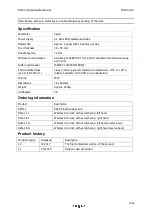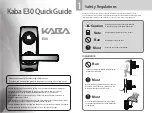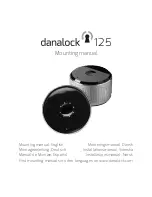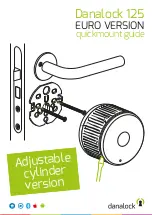
RWL-1 Operating Manual.doc
2020-03-25
6/18
control system. In the
Online mode
access is controlled by the external controller. Transmission
between the lock and controller is wireless and requires intermediary RWH-1 hub. Regardless of the
selected working mode (online or offline) the lock requires configuration which can be done from the
programming computer with the RogerVDM application and connected to the lock through RUD-1
communication interface. If the lock is designated to operate in
Offline mode
with list of 50 users,
each equipped with
Main card
and
Backup card
, it can be programmed manually without computer. In
this scenario, two programming cards, called ADD card and DEL card, are used to program the unit.
Note: Due to the small size of the proximity keyfobs, they may be incorrectly detected by the built-in
proximity sensor. In the RWL series locks, it is recommended to use full-size ISO proximity cards.
Proximity cards
The lock is equipped with a card reader which supports MIFARE® cards. Factory configured device
reads card serial number (CSN -
Chip Serial Number
), but using RogerVDM software it can be
configured to use programmable card number (PCN –
Programmable Card Number
) stored in the
encrypted memory of the MIFARE card.
Card number
The card number which RWL-1 lock reads from the card and returns to the access controller is called
RCN (
Returned Card Number
). In general, the RCN can be composed of two sections:
·
CSN section
·
PCN section
The CSN section is a part of the RCN card number taken from the card serial number (CSN). The
serial number is programmed by card manufacturer.
The PCN section is a part of the RCN card number taken from the card’s programmable memory. The
programmable number can be encrypted with own key in order to enable protection against card
copying.
Due to relatively easy copying of the card serial numbers (CSN), it is recommended to configure the
lock for operation with programmable card numbers (PCN).
Offline mode
In the
Offline mode
, the lock grants access for cards stored in its memory. The lock can operate
permanently in
Offline mode
or enter this mode temporary, when wireless connection with controller
is lost in
Online mode.
Up to 100 cards can be defined and stored in lock’s memory. Each card can be authorised for
momentary door opening (option:
Normal access
) and/or to open the door for unlimited time (option:
Office access
). If the card is authorized for
Normal access
then it opens the lock for the time specified
by the parameter
Lock pulse
. If the card is authorized for
Office mode
then it can open the lock for
unlimited time. When lock is switched to
Office mode
door can be open without use of a card. If the
card is authorised for
Normal access
and
Office mode
then in order to get normal access it must be
used once while in order to activate
Office mode
it must be used twice.
The access to a room from the outside can be blocked with knob switch located at the internal
escutcheon. The functioning of knob can be disabled with the parameter
Don't disturb knob switch.
Backup cards
Up to 100 cards can be defined and stored in lock’s memory. Each card can belong to individual user.
Optionally the lock can operate with 50 users only. In such a case each user can have two cards:
Main
card
and
Backup card
. Both cards have the same authorizations and the enrolment of
Backup card
is
optional. Factory new lock is configured to operate with 50 users. This mode is also used when lock’s
default settings are restored. Switching to 100 users mode can be done only by means of RogerVDM
software. The main benefit of
Backup cards
is to enable selective removing of
Main cards
from the




































